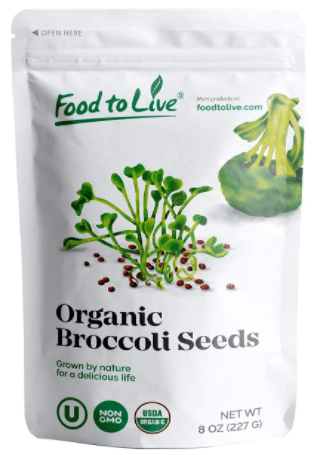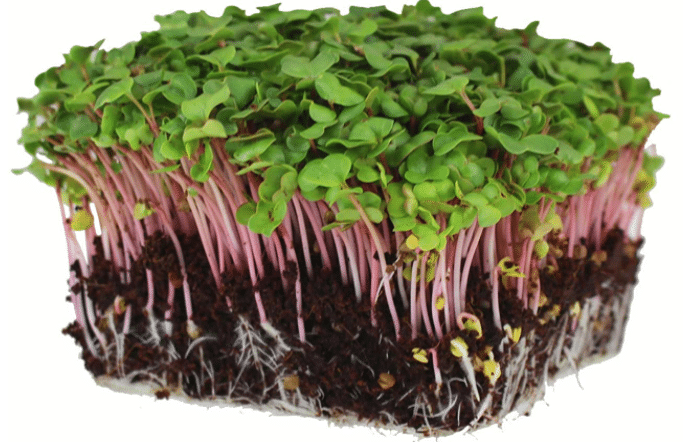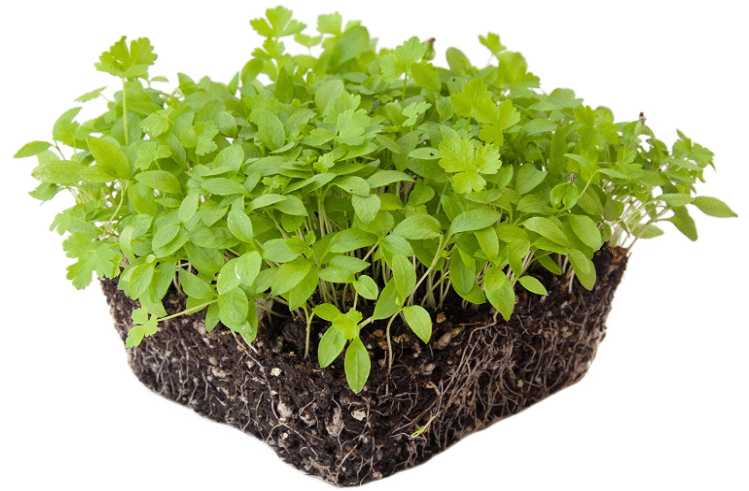8 Best-Tasting Microgreens to Grow Now

Table
of
Contents
If
you
haven’t
tasted
a
salad
or
smoothie
with
microgreens,
you
need
to
ASAP!
One,
you’ll
love
the
flavors.
Two,
the
colors
are
unforgettable.
Three,
microgreens
have
so
much
nutritional
value.
Four,
just
do
it!
BTW,
do
you
know
microgreens
grow
even
in
a
disposable
food
container?
We’ve
rounded
up
the
best-tasting
microgreens,
so
you
can
see
the
many
options
available
to
grow
at
home.
Top
Pick:
Our
best
pick
is
the
Food
to
Live
Broccoli
microgreens
seeds
because
they
come
in
many
size
packs
to
your
favor
if
you’re
a
first-time
grower.
Plus,
broccoli
microgreens
are
among
the
most
delicious.
Read
on!
The
Best-Tasting
Microgreens
Are:
1.
Broccoli
Microgreens
–
Best
Organic
Option

Broccoli
microgreens
grow
fast,
so
you’ll
have
your
first
bunch
of
greens
in
less
than
two
weeks.
These
microgreens
pack
enough
nutrients
to
qualify
for
a
large
portion
of
your
plate.
They
bring
vitamins
A
for
your
immune
system
and
vitamin
C
to
repair
tissues
and
remove
free
radicals.
They
also
have
a
high
quantity
of
sulforaphane,
which
lowers
your
risk
of
cancer.
You
can
add
these
microgreens
to
your
salads,
pizzas,
or
sandwiches
for
a
crunchy
taste
with
a
hint
of
bitterness.
Broccoli
microgreens
are
easy
to
grow
as
you
only
soak
them
in
water
for
up
to
24
hours.
The
packs
are
available
in
various
sizes,
this
particular
one
being
an
8-ounce
pack.
You
can
also
get
2-pound
and
4-pound
packets.
Thus,
it’s
cost-effective
as
you’ll
plant
what
your
household
can
consume.
Key
Features
-
Different
size
packs -
Grows
in
about
two
weeks - Organic
Pros
-
High
nutritional
value -
Easy
to
grow -
Rich
flavor - Affordable
Cons
-
Some
seeds
take
too
long
to
germinate.
Verdict
The
Food
to
Live
broccoli
seeds
bring
a
lot
to
your
diet
as
they
have
minerals
like
calcium
and
vitamins
A,
E,
D
&
B.
They
are
also
rich
in
cancer-fighting
nutrients.
But,
you
have
to
grow
them
first.
Also,
you’ll
need
to
soak
them
for
about
24
hours
and
water
them
daily
to
germinate
fast.
Overall
Rating:
4.3
2.
Salad
Arugula
–
Best
For
Salads

Arugula
can
be
an
ingredient
in
numerous
dishes,
from
scrambled
eggs
to
sandwiches
and
burgers.
But,
you’ll
love
the
spicy
flavor
more
when
you
add
these
microgreens
to
your
salads.
Arugula
microgreens
have
one
of
the
most
beneficial
nutrients—lutein.
It
improves
eye
health,
suppresses
inflammation,
and
fights
free
radicals
in
your
system.
These
microgreens
also
have
beta-carotene.
These
microgreens
have
colorful
green
leaves.
Add
them
to
a
salad
with
red
tomatoes
and
cream-colored
parmesan
cheese,
and
you
have
a
delectable
combo.
Key
Features
-
Grow
all
year
round -
High
germination
rate -
Grown
in
a
tray
with
soil
Pros
-
They
add
flavor
to
salads -
Grow
fast -
Need
a
few
resources
to
grow
Cons
-
Sensitive
to
too
much
moisture
Verdict
In
seven
to
14
days,
arugula
microgreens
will
be
ready.
They
grow
that
fast,
and
they
only
need
a
growing
medium,
water,
and
sunlight.
You
don’t
have
to
pre-soak
them.
Average
Rating:
4.6
3.
Radish
Microgreens
–
Best
For
Quick
Harvest

You
can
harvest
radish
microgreens
in
about
10
days
from
the
day
you
plant
them.
Radish
is
the
most
colorful
of
these
greens
as
some
varieties
have
red
stems
and
green
leaves.
Their
peppery
taste
is
unforgettable,
so
prepare
for
tantalizing
salads
and
omelets.
For
instance,
prepare
a
potato
salad,
pour
your
salad
dressing,
and
sprinkle
some
radish
microgreens
on
top.
Mix
and
serve.
Daisy
Creek
Farms
with
Jag
Singh
shows
you
how
easy
it
is
to
grow
radish
microgreens
at
home.
The
three-minute
tutorial
takes
you
through
the
planting
phase
with
almost
daily
pictures
as
the
seeds
germinate.
In
about
two
days
after
planting,
the
seeds
will
germinate
and
shoot
cotyledons.
Source:
Daisy
Creek
Farms
with
Jag
Singh
Key
Features
-
Tasty
and
peppery -
Rich
in
vitamin
C -
Sprouts
in
48
hours -
Rich
in
fiber
Pros
-
A
bagful
lasts
a
long
time -
Good
germination
rates -
Little
seed
wastage
Cons
-
May
turn
moldy -
Large
seeds
meaning
lower
plant
density
Verdict
Radish
microgreens
stand
out
for
flavor
and
variety.
On
top
of
that,
they
grow
fast,
and
you
can
add
them
to
so
many
dishes,
including
sandwiches.
Average
Rating:
4.4
4.
Dark
Red
Beets
Microgreens
–
Best
For
Indoor/Outdoor
Growing

You’ll
love
their
sweet,
earthy
flavor
in
your
smoothies,
avocado
toast,
and
salads.
Most
people
grow
microgreens
indoors
as
they
aren’t
demanding
plants,
and
they
only
need
water
and
sunlight.
But,
wouldn’t
you
love
to
know
that
you
can
grow
microgreens
in
a
bigger
area
outdoors?
Well,
you
can
grow
beet
seeds
outdoors.
They
germinate
in
about
three
days
and
are
ready
to
pluck
in
a
few
days
or
weeks.
Key
Features
-
Require
sun
exposure -
Blooms
in
summer
to
fall -
11
to
21
days
growing
period
Pros
-
Bold,
lovable
flavor -
Stunning
color -
Grows
indoors
&
outdoors
Cons
-
They
take
more
time
to
grow.
Verdict
Beets
will
have
you
waiting
for
up
to
21
days
before
you
can
enjoy
some
in
your
meals,
but
their
flavor
and
appetizing
color
are
worth
the
wait.
Average
Rating:
4.1
5.
Organic
Sunflower
Microgreens
–
Best
For
Nutty
Flavor

It’s
time
to
up
the
flavors
in
your
meals
by
growing
some
sunflower
microgreens.
Their
texture
is
like
that
of
spinach,
but
they
have
a
nutty
flavor
like
raw
sunflower
seeds.
Your
microgreens
will
be
ready
to
harvest
in
two
weeks
if
you
plant
them
today.
After
that,
it’s
up
to
you
if
you’d
like
to
sprinkle
some
in
your
salad
or
cook
them
in
soups.
Key
Features
-
For
growing
in
a
variety
of
mediums -
Can
grow
in
a
tray - Vegan
- Organic
-
Eight-ounce
pack -
For
planting
in
the
fall
Pros
-
High
germination
rate -
Tasty
microgreens -
Easy
to
grow
in
a
tray
Cons
-
May
mold
if
they
don’t
germinate
fast
Verdict
A
key
to
a
high
germination
rate
is
following
instructions
on
the
type
of
medium
and
how
to
water
your
seeds.
This
pack
of
sunflower
microgreens
is
easy
to
grow,
and
the
yields
are
commendable.
Average
Rating:
4.2
6.
Ohio
Heirloom
Kale
–
Best
for
Antioxidants

Kale
microgreens
are
delicious
in
soups,
stews,
pasta,
and
so
many
other
dishes,
not
to
mention
you’ll
get
numerous
nutrients.
They
bloom
in
several
seasons
like
winter,
summer,
and
spring,
something
that’ll
ensure
you
have
microgreens
on
your
plate
throughout.
You’ll
also
have
up
to
5,000
seeds
that
can
grow
enough
greens
for
a
few
months.
Therefore,
it’ll
be
economical
to
grow
your
microgreens
than
get
them
from
a
farmer’s
market.
Plus,
the
harvest
time
is
a
week
or
two
from
the
day
you
plant
them.
They
don’t
require
too
many
resources
to
grow
them;
you
can
use
a
soil
mix
or
moist
paper
towels.
Key
Features
-
About
5,000
seeds -
Harvested
in
7
to
14
days -
Grown
in
several
seasons -
Can
grow
indoors
Pros
-
Grows
fast -
Minimal
planting
resources -
Rich
in
nutrients
like
antioxidants
Cons
-
Germination
not
guaranteed
Verdict
Kale
microgreens
have
a
rich
flavor
that
almost
tastes
like
broccoli.
Average
Rating:
4.4
7.
Country
Creek
Acres
Garlic
Chives
–
Best
Herb
Microgreens

Chives
are
some
of
the
oldest
herbs.
Their
microgreens
bring
a
mild
garlic
and
onion
flavor
to
your
potato
salad,
pizza,
fish,
and
a
whole
lot
of
other
dishes.
You
can
use
these
microgreens
as
a
garnish.
Even
as
you
enjoy
the
taste,
you’ll
also
be
sampling
the
medicinal
and
nutritional
value
of
chives.
For
instance,
they
have
choline
and
folate
to
improve
your
memory
and
cancer-fighting
compounds
like
sulfur.
Key
Features
-
Grow
indoors -
Full
sun
exposure -
Aromatic
flavor
Pros
-
Medicinal
benefits - Flavorful
Cons
-
They
need
sun
exposure.
Verdict
Chives
take
between
14
and
25
days,
so
you
have
quite
some
time
before
you
can
enjoy
this
flavorful
herb.
Average
Rating:
4.6
8.
Parsley
Microgreens
–
Best
For
High
Seed
Count

You
may
not
have
to
buy
garnish
when
you
have
up
to
18,000
seeds
to
grow
in
a
container
on
your
window
sill.
Every
21
days,
you
get
a
bountiful
harvest
of
parsley
microgreens.
It
could
even
become
a
small
business
where
you
supply
family
and
friends
with
these
greens.
Parsley
microgreens
will
bring
a
mild
taste
to
your
smoothies;
mix
them
with
apples,
bananas,
strawberries,
and
dates
for
a
nutritious
smoothie.
They
also
add
color
and
flavor
to
salads.
Key
Features
-
They
grow
in
soil
medium -
About
18,000
seeds -
Take
21
days
to
grow
Pros
-
High
favor
intensity -
Mild
flavor -
Garnish
for
any
dish
Cons
-
Slow
germination
rate
Verdict
Parsley
has
so
many
health
benefits
that
you’ll
want
a
handful
of
parsley
microgreens
in
every
meal.
It
improves
liver
health,
strengthens
your
immunity,
and
inhibits
some
cancers.
Average
Rating:
4
Why
Are
Microgreens
Very
Popular?
They
Grow
Fast
The
seeds
germinate
into
microgreens
between
seven
and
25
days,
depending
on
the
variety.
Thus,
you’re
sure
to
have
fresh,
small
greens
every
day
if
you
plant
various
types.
Since
they
don’t
take
up
a
lot
of
space,
you
can
plant
two
varieties
in
separate
containers
to
add
diversity
to
your
daily
greens.
They
Are
Nutritious
Microgreens
get
the
title
superfoods
for
a
reason,
as
they
have
more
nutrients
than
mature
greens.
It’s
a
fact
that
you’ll
be
getting
antioxidants,
vitamins,
and
minerals
to
fight
diseases
like
cancer
and
diabetes.
For
example,
when
you
mix
sunflower
and
basil
microgreens,
100
g
of
the
mixture
has
88
mg
of
calcium,
2.2
g
fiber
content,
and
other
nutrients
like
potassium
and
iron.
On
top
of
that,
they
increase
fiber
content
in
your
system
to
improve
gut
health.
It’s
easier
to
get
nutrients
from
microgreens
because
you
can
add
them
to
so
many
meals
in
a
day.
For
example,
you
can
have
some
beets
in
your
breakfast
smoothie
and
for
lunch,
garnish
your
baked
chicken
with
parsley
microgreens.
Easy
to
Grow
Yes,
you
can
grow
different
varieties
in
a
container
placed
on
your
window
sill.
It’s
such
a
simple
process
that
you’ll
even
make
it
a
hobby.
Imagine
misting
seeds
every
day
for
about
seven
days
only,
and
you
have
microgreens
to
harvest.
There’s
no
tedious
plowing
or
weeding
like
it
is
with
mature
greens.
But
you
should
be
able
to
distinguish
it
from
sprouts.
Check
out
this
guide
on
sprouts
vs
microgreens.
Suit
Many
Dishes
Microgreens
are
delicious
as
garnishes
in
salads,
vegetable
soups,
and
pizzas.
You’ll
also
love
them
in
juice
and
smoothies,
omelets,
frittatas,
burgers,
sandwiches,
and
tacos.
FAQS
Do
Microgreens
Taste
Good?
Yes,
microgreens
are
some
of
the
most
flavorful
foods
you’ll
come
across.
They
have
a
variety
of
tastes,
from
nutty
flavor
to
mint
and
earthy.
You
have
to
know
what
you’re
about
to
add
to
your
salad
or
meat
dish
as
some
microgreens
are
bitter.
Do
we
start
with
the
good
stuff
or
give
you
the
awful
flavors
first?
Let’s
first
mention
the
good
stuff,
the
kind
you
want
in
your
meals.
Sweet-flavored
microgreens
include
beets,
fennel,
chard,
kale,
sunflower,
and
turnip.
Spicy
microgreens
include
radish,
arugula,
and
flax.
There
are
also
microgreens
with
a
mild
taste,
such
as
parsley,
broccoli,
basil,
and
chives.
The
other
batch
is
the
type
that
should
never
cross
your
mind
because
they
have
a
pungent
taste.
They
include
oregano
and
cilantro.
Oh!
And
the
colors
microgreens
bring
to
your
plate
will
have
you
looking
forward
to
your
next
salad
bowl.
What
Are
the
Sweetest
Microgreens?
A
few
sweet
ones
are
turnip,
sesame,
lettuce,
and
pak
choi.
We’ve
listed
more
above.
What
Are
the
Fastest
Growing
Microgreens?
Microgreens
that
grow
in
one
to
two
weeks
are
the
fastest-growing.
These
include
radish,
which
takes
seven
to
15
days,
and
lettuce,
which
takes
between
eight
and
12
days.
In
10
to
15
days,
you
can
harvest
cress,
sesame,
kale,
sunflower,
mustard,
pak
choi,
and
turnips.
What
Microgreens
Do
Chefs
Use?
Chefs
have
many
varieties
to
choose
from,
so
we’d
have
to
list
over
100
types
of
microgreens
they
love.
Thus,
we
can
say
that
chefs
use
microgreens
for
different
purposes.
For
instance,
they
use
them
for
visual
appeal
and
balancing
the
flavors
and
colors.
All
the
microgreens
that
can
do
that
will
find
their
way
into
a
restaurant’s
kitchen.
Some
mustard
purple
beside
the
red
stems
of
radishes
and
the
green
leaves
of
cress
makes
one
colorful
plate.
Don’t
you
think
so?
Final
Thoughts
Microgreens
aren’t
a
new
thing,
as
many
who
love
them
have
been
planting
them
for
decades.
Food
to
Live
Broccoli
seeds
stood
out
for
us
because
of
their
nutritional
value
compared
to
mature
greens.
They
have
a
mild,
appealing
taste,
and
they
take
only
two
weeks
to
grow.
To
grow
them,
you
need
a
medium
like
soil,
a
container,
sunlight,
and
water.
That’s
it!
Plus,
they
are
organic
seeds.
As
you
decide
to
start
a
small
garden
of
microgreens
on
your
window
sill,
consider
the
flavors
you
want
in
your
food,
the
appealing
colors
you’d
like
to
see,
and
the
duration
the
seeds
take
to
germinate.
